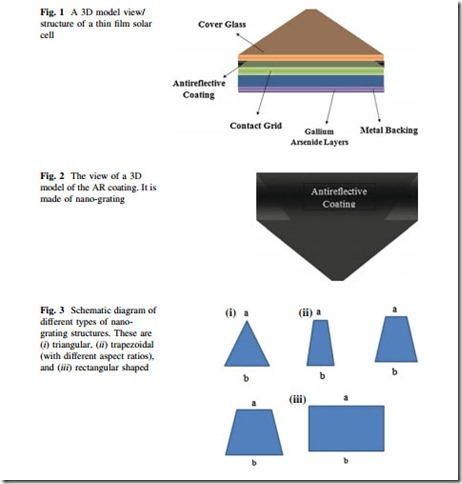Basic Structure Thin Film Solar Cell
Figure 1 shows a three-dimensional (3D) view of a thin film solar cell. The AR coating lies below the cover glasses. The contact grid holds the gallium arsenide (GaAs) substrate and the AR coating together, the bottom layer is the metal backing.
Figure 2 shows the view of a 3D model of the AR coating. The AR coating is made of nano-grating structures.
Figure 3 shows different types of nano–grating structures that are used for the modeling. These are mainly (i) triangular shaped nano-grating, (ii) trapezoidal shaped nano-gratings with different aspect ratios, and (iii) rectangular shaped nano-gratings. By varying the aspect ratios, it is possible to make a triangular shaped nano-grating structure (when the aspect ratio is ‘0’); trapezoidal shaped nano-grating structure (when the aspect ratios are [0 and \1; however typically, it is ‘0.1-0.9’); and rectangular shaped nano-grating structure (when the aspect ratio is ‘1’).
The aspect ratio is defined as the ratio between the top length over the base length of a trapezoid, triangle, or a rectangle. For a triangular shaped nano-grating structure: the aspect ratio is ‘a/b’ = ‘0’. For the trapezoidal shaped nano-grating structure: the aspect ratio is ‘a/b’ [‘0’ and \‘1’; typically, it is from ‘0.1’ to ‘0.9’. For a rectangular shaped nano-grating structure: the aspect ratio is ‘a/b’ = ‘1’, because ‘a’ is equal to ‘b’.
Subwavelength grating (SWG) structures have been identified as promising candidates for realising high conversion efficiency in solar (photovoltaics) cells Fig. 1 A 3D model view/ structure of a thin film solar cell Fig. 2 The view of a 3D model of the AR coating. It is made of nanorating Fig. 3 Schematic diagram of different types of nanograting structures. These are (i) triangular, (ii) trapezoidal (with different aspect ratios), and (iii) rectangular shaped
due to their low reflection losses. If the pitch (or period) of a single grating structure is less than the wavelength of the incident light, it behaves like a homogeneous medium with an effective refractive index [8]. Therefore, the SWG structures provide gradual changes in refractive index that ensure an excellent AR and light trapping properties compared to a planar or flat type thin film [8, 9]. This type of nanorod (or nano-grating) structure acts as a single layer AR coating, whereas the triangular (such as conical or perfect cone) and parabolic shaped nanograting structures act as a multilayer broadband AR coating [10, 11].
As reserves of fossil fuels are used up, the need to find an alternative source of energy arises. The solar, hydroelectric, wind, and biomass are considered as renewable energy sources that can be used in a wide range of applications from heating water and generating electricity to supply for telecommunications and transportations, etc. Renewable energy is a clean energy being environmentally friendly. Therefore, the solar cell is a very important area of research for the generation of renewable or green energy in the sustainable future. The solar cell was discovered in the nineteenth century and since then scientists and researchers have been trying to improve its conversion efficiency which is currently 20.3 % for the best reported silicon solar cells [12].
There are various types of losses in solar cells that always reduces the con- version efficiency of solar cells. Among them, reflection loss is one of the most important factors that reduces the conversion efficiency significantly in solar cells. The thin-film AR coating can minimize the reflection losses only for certain wavelengths and the formation of coating film can be a complex process as well having some other drawbacks, such as adhesion and thermal mismatch, etc., and instability under thermal cycling [9, 11]. Therefore, the SWG structure (especially triangular or conical shaped) causes a gradual change in refractive index that lead to a lower reflection losses over a wide range of wavelengths and angles of incidence [9, 11, 13–16].
Finite-difference time domain (FDTD) method is used to simulate the reflection losses for different types of nano-grating structures. The nano-grating profiles are rectangular and triangular (i.e., conical or perfect cone) shaped. From simulation results, an optimum nano-grating height and pitch (or period) for the SWG structures were obtained. If the nano-grating structure has a shorter pitch (or period) than the wavelength of the incident light, it acts as a homogeneous medium with an effective refractive index. The reflection loss for a rectangular shaped SWG structure is[30 %, however, for a triangular (conical or perfect cone) shaped SWG structure, the refractive index changes gradually in several steps and finally the reflection loss becomes *2 %. However, the intermediate structures (such as, trapezoidal or truncated cone and parabolic shaped), the reflection loss is lower than the rectangular shaped SWG structure but higher than the triangular (i.e., conical or perfect cone) shaped SWG structure. This reduction of reflection losses in solar cell confirms the improvement of the efficiency in solar cells. The optimized SWG structures confirm that the reflection loss is *2 %, which is *28 % less than that of a flat type substrate or a rectangular shaped grating structure.
